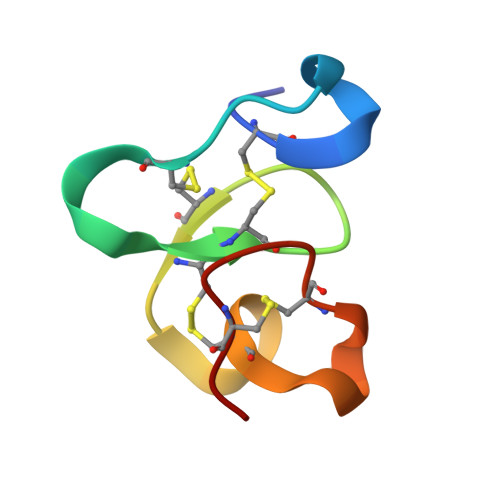Impact of the vulcanization process on the structural characteristics and IgE recognition of two allergens, Hev b 2 and Hev b 6.02, extracted from latex surgical gloves.
Galicia, C., Mendoza-Hernandez, G., Rodriguez-Romero, A.(2015) Mol Immunol 65: 250-258
- PubMed: 25700348
- DOI: https://doi.org/10.1016/j.molimm.2015.01.018
- Primary Citation of Related Structures:
4WP4 - PubMed Abstract:
Latex allergy is a health problem that mainly affects medical environments, causing anaphylactic shocks in extreme cases. Sensitization and reactions to this material is closely linked to the use of latex gloves. The objective of this study was to purify two of the major allergens from latex surgical gloves to study the biochemical and structural changes that could be generated during the product manufacture and to compare their IgE recognition with the non-processed allergens. Glycosylated allergen Hev b 2 (β-1,3-glucanase) and Hev b 6.02 (hevein) were purified from glove extracts using affinity (Concanavalin A) and reversed-phase chromatographies, respectively. ELISA experiments were performed with both proteins and sera from allergic patients to assess the IgE recognition, which was heterogeneous. Crystallographic methods were used to obtain the 3D structure of Hev b 6.02 from surgical gloves, which did not show evident modification when compared with the protein from the natural non-processed form. Despite having the same crystallographic structure, the IgE from some patients showed different recognition when the glove and the natural allergen were used in ELISA. Furthermore, using electrophoretic techniques, we identified three forms of Hev b 2: one corresponding to the complete polypeptide chain with posttranslational modifications, and two glycosylated fragments. The mixture of these three forms showed stronger recognition by IgE from latex-allergic patients than the pure non-processed allergen. In conclusion, IgE from subjects sensitized to latex products showed different recognition between the allergens obtained from a natural source and the processed material, even when the structure was maintained. This demonstrates the importance of using processed allergens in further investigations of diagnosis, prevalence, product allergenicity, and therapies.
Organizational Affiliation:
Instituto de Química, Universidad Nacional Autónoma de México, Ciudad Universitaria, Mexico.















